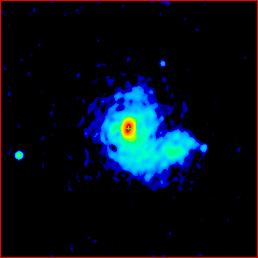 Image:
Image:3C 84 | B0316+413 |
| S178 | Alpha | FR | Class | ID | Spectrum | Best z | mag. | LAS | lg P178 | D |
|---|---|---|---|---|---|---|---|---|---|---|
| 66.8 | 0.78 | I | RD/SSC | Gal | 0.0179 | R(c) = 11.17 | 1350.00 | 24.52 | 454.0 |

| Size: | 1024.0 × 1024.0 arcsec² |
|---|---|
| LUT: | Logarithmic |
| Beam: | 21 arcsec |
| Frequency: | 1380 MHz |
| Method: | SDCLN Õ˜ÿ>21
|
| Telescope: | VLA C+D |
| Credits: | Pedlar et al. (1990) |
NGC 1275 was one of the original group of six galaxies with strong nuclear emission lines studied by Seyfert (1943), which gave rise to the term Seyfert Galaxy. However NGC 1275 differs from the other five in that it is a radio-loud elliptical instead of a radio-quiet spiral, and hence it is now generally regarded as a radio galaxy rather than a Seyfert Galaxy. (Curiously, Seyfert thought that it was a spiral, partly because a spiral galaxy in the cluster is seen projected in front of NGC 1275, and makes its optical structure appear much more complicated than a normal elliptical).
NGC 1275 is at the centre of a massive cooling flow visible in X-ray images of the Perseus cluster (see Richard White's Perseus Cluster page).
The radio structure is complicated and particularly difficult to
image well. At the very centre is an extremely bright flat-spectrum
core, often imaged with VLBI (e.g.
Romney et al. 1996). In our image
this has been subtracted to make the extended structure more visible;
its position is marked by the green cross at the centre of the red
region. The latter is the steep-spectrum core (SSC) which at higher
resolution is a pair of lobes with the southern one dominated by
a knotty jet. On larger scales still lies the extended halo, which dominates
our image. The
small-scale ripples ringing the central peak are artifacts caused
by the bright central core. The compact peaks at the left of the picture
and to the NNW of the centre are background radio sources, while
the compact feature at the western tip of the structure is the
nucleus of another Persues cluster galaxy, NGC 1272. The lack of
compact structure in the halo gives this object its Relaxed Double
classification. In fact the halo is much larger than is visible
here, essentially filling the region covered by this picture. The
full extent is shown in the C20 image.
| Prev. | Data Page | Other images | Next | Search | Alphanumeric List | Icon List | Atlas Index |
|---|